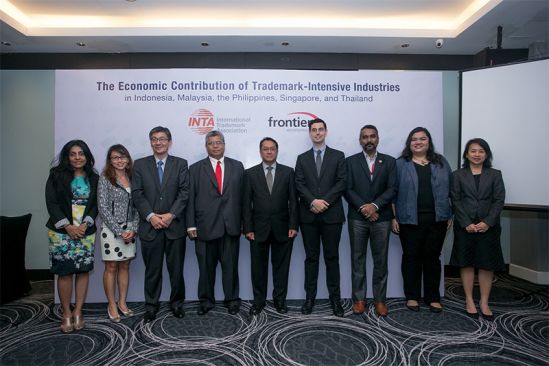A new impact study released yesterday by the International Trademark Association (INTA) reports that industries which intensively use trademarks contribute significantly to five major economies in the Association of Southeast Asian Nations (ASEAN) region.
Analysis from The Economic Contribution of Trademark-Intensive Industries in Indonesia, Malaysia, the Philippines, Singapore, and Thailand indicates that trademark-intensive activities generate increased employment across sectors and added contributions to international trade.
Trademark-intensive industries are defined as those industries which file more trademarks than other industries–weighted against total employment in that industry.
The release of the report coincides with the 50th anniversary of the ASEAN, which has successfully grown to become the world’s seventh-largest market and home to the third-largest labor force over the last half century.
INTA commissioned the report from Frontier Economics, an internationally recognized economics research firm. The study is the first of its kind to analyze the correlation between trademarks and their economic impact on contribution to Gross Domestic Product (GDP), share of exports, and employment in major markets of Southeast Asia.
Specifically, looking at data from 2012 to 2015, trademark-intensive industries within Malaysia generated a 30.3% direct contribution to GDP and 60% indirect contribution to GDP, reflecting a direct correlation between trademark-intensive and non-trademark intensive industries.
Trademark-intensive industries in Malaysia comprised 55% of the country’s share of exports, including manufacturing of computers, and electronics and related equipment which accounted for around 19% of total manufacturing value added. In terms of employment, output, and value-added, workers’ share of the workforce represented 24% of total employment.
“Trademark-intensive industries in Malaysia yield considerable economic benefits that directly impact employment rates and productivity,” noted INTA Member Michael C.M. Soo, Deputy Managing Partner, Shook, Lin & Bok, Kuala Lumpur, Malaysia. "Evidence from this study indicates the nexus between trademarks and positive contributions to economic development and international trade in major economies within the ASEAN region.”
INTA CEO Etienne Sanz de Acedo said the results of the new study “underscore the immense potential for cross-sectoral economic growth that can be unlocked by promoting the value of trademarks with the business community, government, and the general public, and by further developing national trademark systems and trademark-intensive industries. As we explore the long-term economic and social implications of trademarks and related intellectual property (IP) rights, it becomes increasingly important for both public and private sectors to scale up engagement on this issue, as well as support government efforts to further trademark and brand development and protection, including protection of goods in transit.”
Building on similar methodologies used by the European Union Intellectual Property Office (EUIPO) and the United States Patent and Trademark Office (USPTO), findings from the ASEAN report echo emerging analytical trends with regard to trademark-intensive activity.
In the European Union, from 2011 to 2013, IP-intensive industries generated more than 42% of total economic activity; trademark-intensive industries alone produced 36% (€4.8 trillion) of that activity and generated nearly 46 million jobs (21%). A similar study conducted by the USPTO also found that IP-intensive industries continue to be a major, integral, and growing part of the U.S. economy.
In 2014, trademark-intensive industries accounted for 23.7 million jobs in the U.S. In Latin America, according to a recent study commissioned by INTA of trademark-intensive industries in Chile, Colombia, Panama, Peru, and Mexico, from 2010 to 2014, their contribution to GDP varied between 10% and 21%, and. workers’ share of the workforce ranged from 8% to 26% of total employment.







